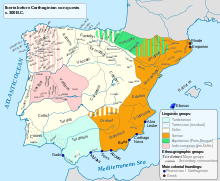Edetani
The Edetani or Edetanii , in German Edetaner , were a tribal group of the Iberians who inhabited the region around today's Valencia on the Iberian Peninsula in prehistoric times .
In prehistoric times
The settlement area extended roughly between the rivers Palancia and Udiva in the north (on the border with today's province of Castellon) and Júcar (Valencian Xúquer ) in the south (see also Province of Valencia ). The neighboring Lobetans (Lobetani) and Arevacians (Arvatkos) - these were Celtiberians - settled in the west.
There were contacts to Phoenician and Greek branches, including a. via Sagunto (founded by Dorian settlers, the colony fell to the Edetans in the course of the 5th century BC).
The administrative center of the resident population was Edeta , one of the most important Iberian settlements of the time. Originally this city was in the 5th century BC. On and along a hilltop (Tossal). The modern Llíria (Spanish Liria) is located at the foot of the old settlement.
The elevation from which the present city can be seen has been called Tossal de Sant Miquel since the Middle Ages . There is a monastery complex dedicated to St. Michael ( Monestir de Sant Miquel ), founded in the 14th century.
Settlements of the Edetans included fortified hamlets on ridges similar to the Celtiberian castrum , such as the Poblado ibérico del Castellet de Bernabé from the 5th century BC, Puntal dels Llops and La Torre Seca , as well as villages around Edeta such as La Monravana .
In historical time
Carthaginian expansion
Later, the Edetans came under the influence of Carthage , which gained power in the course of the 3rd century BC. BC had spread over the Iberian Peninsula to the Ebro . In the second Punic War they fought on the side of the Romans (see Battle of Baecula , 208 BC) under Publius Cornelius Scipio against Hasdrubal Barkas . The Carthaginians were finally born in 206 BC. Expelled from Hispania.
Under Roman rule
From the 2nd century BC First came the east of Iberia, and with it Edeta, as the province of Hispania citerior under Roman control, the province of Hispania ulterior only included the south of the peninsula, thus originally Carthaginian possessions. Further conquests against the Celtiberians in the west followed.
The north-west (the area between the western end of the Pyrenees and Galicia and northern Portugal) was only slowly occupied by the Romans. At the end of the 1st century BC Chr. Was towards Hispania finally part of the empire.
As a result of political turmoil in Rome (rule of the Populares), the newly won provinces were drawn into military conflicts. The praetor and governor Quintus Sertorius could from 83 BC. BC with his quaestor Lucius Hirtuleius to build up a rule independent of Rome in the two Hispanic provinces for several years. He successfully defended himself against Gnaeus Pompeius Magnus , who 76 BC. Came to Spain with armed forces, but finally fell in 72 BC. Victim of a conspiracy.
Edeta's task and founding of Llíria
After troops under Quintus Sertorius in 76 BC When the old Edeta was destroyed in the course of the clashes, the remaining residents founded a new settlement (today's Llíria ) on the plain around the turn of the ages .
In later times Llíria , like Valencia or Sagunto, was still an important settlement in Hispania, with temples and Roman baths ( thermal baths ); the oracle sanctuary of Mura or the "Santuario y Termes Romanes de Mura", as well as mausoleums - the "Mausoleos romanos".
Language and writing
It is assumed that the Edetans spoke the Iberian language , at least in one of its own forms (dialect). This seems to have been an isolated language , so it is probably not related to the Celtiberian language. The Iberian was between the 7th and 1st centuries BC. In use until it, like the Celtiberian, was replaced by the Latin language in the course of the progressive Romanization (Ibero-Romansh).
The Edetans, and neighboring groups, were the bearers of the Northeast Iberian script , one of the ancient Hispanic scripts that were used from the 4th to the 1st century BC. Was used on the Iberian Peninsula. This in turn shows a strong resemblance to the Celtiberian script. Longer texts were written on lead plates; the longest text found so far ( Los Plomos del Pico de los Ajos ) on several plates comes from the area of Yátova , which was part of Edeta's domain.
literature
- Michael Koch (Ed.): The Iberians . Exhibition catalog Bonn, Art and Exhibition Hall of the Federal Republic of Germany, May 15 - August 23, 1998. Hirmer Verlag, Munich 1998, ISBN 3-7774-7710-9 .
- Michael Kunst: Zambujal (= Madrid contributions. Volume 5). von Zabern, Mainz 1987, pp. 9-17 (on the history of the term “Iberians” in Spanish archeology).
- Ángel Montenegro et al .: Historia de España 2 - colonizaciones y formación de los pueblos prerromanos (1200-218 aC). Editorial Gredos, Madrid 1989, ISBN 84-249-1386-8 .
- Francisco Burillo Mozota: Los Celtíberos, etnias y estados. Crítica, Grijalbo Mondadori, SA, Barcelona 1998, revised edition 2007, ISBN 84-7423-891-9 .
Individual evidence
- ↑ Iberian settlement Edeta , Tossal de Sant Miquel
- ^ Monastery of Real Monasterio de San Miguel , Tossal de Sant Miquel
- ^ Hamlet El Castellet De Bernabé , Partida rural de la Concordia
- ↑ La Monravana settlement , Llíria
- ↑ Sanctuary and Termes Romanes de Mura , Llíria
- ↑ The Mausoleus Romanus , Llíria








